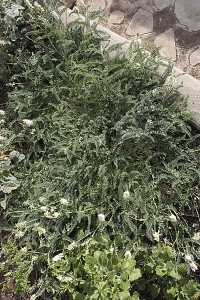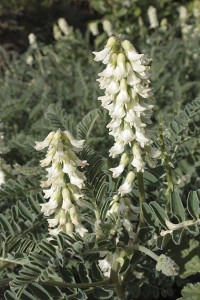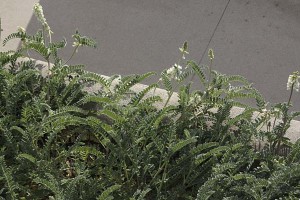I wrote earlier about a little patch of Nuttall’s milkvetch (Astragalus nuttallii), a new California native groundcover I’m trying out. Last time, I was pretty enthusiastic. Now, after eight weeks with less than a quarter inch of natural rainfall, I’m a little less excited.
At this point, at the end of April/beginning of May, the plant continues to be interesting up close: a mix of reddening stems, small green-gray leaves and dramatic red-tinged cream-colored pods.
When the seeds have ripened inside the pods, they rattle in a really interesting way. You can see why many Astragalus are called “rattlepod”:
But the down-side about this plant, I’m finding out, is how it looks from a distance. The red stems, whitish pods and green leaves all give the impression of a brown, dying plant. Just squint while looking at the next image and you can begin to see that it’s not the most kempt looking selection for one of the first things you encounter.
This introduction might work well in an informal area, mixed in with big plants that will take up the slack when this one takes a vacation. A spot that gets occasional garden water also might keep this plant looking nicer, longer. But since I planted it at eye-level, right at the front sidewalk in a spot that gets no supplemental water all summer, I’ve decided it’s probably not the right plant for this spot.
So…I’ve cut it back pretty heavily, and it may be out of this spot if it doesn’t look a lot better quickly. That’s the fate of a lot of California natives: They look great during the cool, wet growing season, but look less wonderful during when it dries out and get hotter, which unfortunately also happens to be the season when people want to be outdoors, enjoying their gardens.
Don’t let that discourage you from planting natives, however. Some of the buckwheats I’ve planted next to the milkvetch are still green all over and are about to begin their long season of flowers and dramatic dried seed heads. And there are many other options for plants that look good throughout the year. It’s just a matter of finding the right plant for the right spot in the garden.





